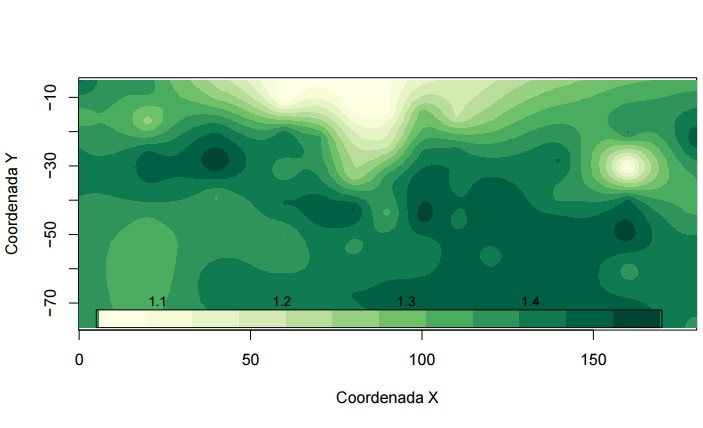Comparação entre o método laboratorial e o penetrômetro de Stolf na análise da densidade do solo
um estudo utilizando abordagens geoestatísticas
Palavras-chave:
Densidade do solo, amostragem do solo, Geoestatística, Krigagem Ordinária, Penetrômetro de StolfResumo
The agricultural sector is a cornerstone of economic development in several countries, including Brazil, as it significantly contributes to the Gross Domestic Product and job creation. However, the pursuit of higher agricultural productivity has led to the use of heavy machinery, resulting in soil structure modification. Consequently, when desiring to cultivate a specific crop, the study of the soil's physical-chemical factors becomes crucial, yet this study is costly and may pose a financial obstacle, as not all researchers can cover the expenses, leading some to abandon their research in the absence of funding. This issue underscores the need to investigate less costly techniques with results closely approximating those obtained through laboratory analysis. This study aimed to assess the accuracy of soil density estimated by the Stolf impact penetrometer, taking laboratory density as a reference. Additionally, the research included a description of soil sampling methods, soil density determination, and basic geostatistical concepts. For this research, 78 soil samples and an equal number of impact measurements were collected in a coffee plantation in Minas Gerais, Brazil. Based on these data, exponential models were fitted, and soil density was mapped using ordinary kriging. The results revealed that the Stolf penetrometer tends to overestimate soil density, although it still exhibits a strong positive correlation (79.3%) with laboratory measurements. Therefore, it was concluded that in situations where precision is not imperative, this cost-effective approach is a viable option for soil density analysis in soil research.
Keywords: Soil density; Soil sampling; Geostatistics; Ordinary Kriging; Stolf's penetrometer.
Referências
CARTER, M.R.; GREGORICH, E.G. Soil sampling and methods of analysis. 2nd edition. Taylor & Francis Group, LLC.
CHILÈS, J. P.; DELFINER, P. Geostatistics: Modeling Spatial Uncertainty. 2nd edition, John Wiley & Sons, Inc., Hoboken, New Jersey, 2012.
CRASSIE, N. A. Statistics for spatial data. revised edition. John Wiley & Sons, Inc., 1993.
DELGADO, R. T.; MULLER, U. Geostatistics for Compositional Data with R. Springer Nature Switzerland AG. 2021.
DIGGLE, P. J., MENEZES, R. e SU, T. (2010) Geostatistical inference under preferential sampling. Journal of the Royal Statistical Society: Series C (Applied Statistics), 59, 191-232.
DIGGLE, P.J.; RIBEIRO Jr, P.J. Model-based Geostatistics. Springer Science + Business Media, LLC. 2007.
EASH, N.S.; SAUER, T. J.; O'DELL, D. ; ODOI, E. Soil Science Simplified. 6th Edition. John Wiley & Sons, Inc., Hoboken, New Jersey, 2016.
EMBRAPA. VII plano diretor da MakeUppercaseembrapa: 2020-2030. Brasilia, DF : Embrapa, 2020.
ISAAKS, E. H.; SRIVASTAVA, R. M. Applied geostatistics. Oxford University Press, Inc. New York, 1989.
JOURNEL, A. G.; HUIJBREGTS, C. J. Mining Geostatistics. ACADEMIC PRESS INC. Centre de Geostatisrique, Fontainebleau, France, 1989.
KLUTE, A.; PAGE, A. Methods of soil analysis. Part 1. Physical and mineralogical methods. American Society of Agronomy, Inc., 1986.
LAL, R.; SHUKLA, M. K. Principles of soil physics. Marcel Dekker, Inc. New York, 2005.
MARTINS, C. A. S. et al. Avaliação da compactação de um latossolo vermelho amarelo sob diferentes coberturas vegetais. Biosci. J., Uberlândia, v. 26, n. 1, p. 79-83, 2010.
OYANA, T. J. Spatial Analysis with R: Statistics, Visualization, and Computational Methods. 2nd edition, Taylor & Francis Group, LLC. 2021.
PLASTER, E.J. Soil Science and Management, 6th Ed. Delmar, Cengage Learning. 2014.
R CORE TEAM. it R: A language and environment for statistical computing. R Foundation for Statistical Computing, Vienna, Austria. 2012. ISBN 3-900051-07-0. Disponível em: urlhttp://www.R-project.org/.
RAKSHIT, A.; SINGH, S. K.; ABHILASH, P. C.; BISWAS, A. Soil Science: Fundamentals to Recent Advances, Springer Nature Singapore Pte Ltd. 2021.
RIBEIRO Jr., P.J.; DIGGLE, P.J. geoR: A package for geostatistical analysis. R-NEWS, Vol 1, No 2, 15-18. ISSN 1609-3631. 2001.
STOLF, R.; MURAKAMI, J. H.; BRUGNARO, C.; SILVA, L. G.; SILVA, L. C. F. d.; MARGARIDO, L. A. C. Penetrômetro de impacto stolf-programa computacional de dados em excel-vba. Revista Brasileira de Ciência do Solo, SciELO Brasil, v. 38, p. 774-782, 2014.
SOARES, A. Geoestatística para as ciências da terra e do ambiente. [S.l.]: Instituto Superior Técnico, 2006.
TEIXEIRA, P. C.; DONAGEMMA, G. K.; FONTANA, A.; TEIXEIRA, W. G. et al. Manual de métodos de análise de solo. [S.l.]: Embrapa Brasília, DF, 2017.
WEIL, R. R.; BRADY, N. C. The Nature and Properties of Soils. 15th edition. Pearson Education Limited. 2017.
YAMAMOTO, J. K.; LANDIM, B. P. M. Geoestatística: conceitos e aplicações. São Paulo : Oficina de Textos, 2013.

Downloads
Publicado
Como Citar
Edição
Seção
Licença
Proposta de Política para Periódicos de Acesso Livre
Autores que publicam nesta revista concordam com os seguintes termos:
- Autores mantém os direitos autorais e concedem à revista o direito de primeira publicação, com o trabalho simultaneamente licenciado sob a Licença Creative Commons Attribution que permite o compartilhamento do trabalho com reconhecimento da autoria e publicação inicial nesta revista.
- Autores têm autorização para assumir contratos adicionais separadamente, para distribuição não-exclusiva da versão do trabalho publicada nesta revista (ex.: publicar em repositório institucional ou como capítulo de livro), com reconhecimento de autoria e publicação inicial nesta revista.
- Autores têm permissão e são estimulados a publicar e distribuir seu trabalho online (ex.: em repositórios institucionais ou na sua página pessoal) a qualquer ponto antes ou durante o processo editorial, já que isso pode gerar alterações produtivas, bem como aumentar o impacto e a citação do trabalho publicado (Veja O Efeito do Acesso Livre).
